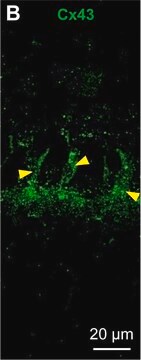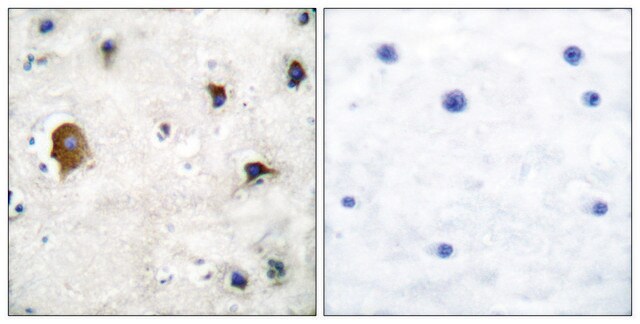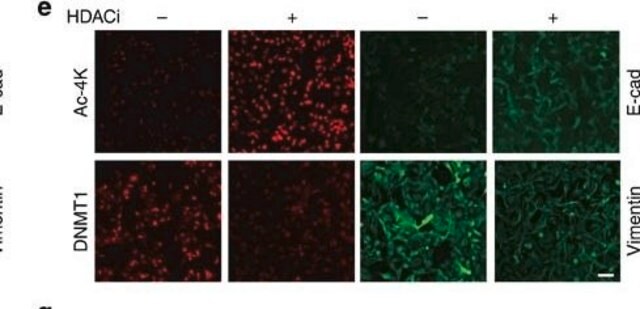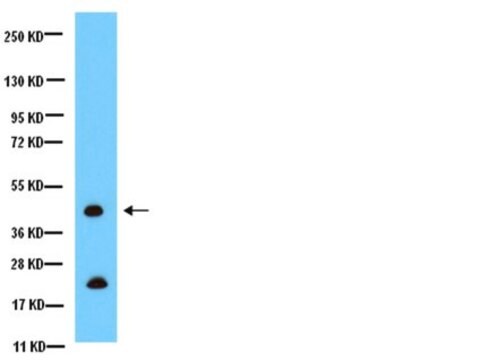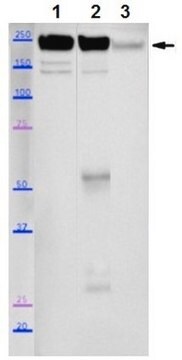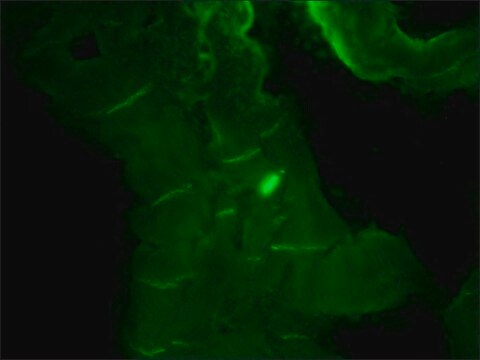AB1727
Anti-Connexin 43 Antibody
CHEMICON®, rabbit polyclonal
Sinônimo(s):
Gap Junction alpha-1 Protein (CxA-1)
About This Item
Produtos recomendados
Nome do produto
Anti-Connexin 43 Antibody, Chemicon®, from rabbit
fonte biológica
rabbit
Nível de qualidade
forma do anticorpo
affinity isolated antibody
tipo de produto de anticorpo
primary antibodies
clone
polyclonal
purificado por
affinity chromatography
reatividade de espécies
mouse, bovine, rat
fabricante/nome comercial
Chemicon®
técnica(s)
ELISA: suitable
immunocytochemistry: suitable
immunohistochemistry: suitable
immunoprecipitation (IP): suitable
western blot: suitable
nº de adesão NCBI
nº de adesão UniProt
Condições de expedição
wet ice
modificação pós-traducional do alvo
unmodified
Informações sobre genes
human ... GJA1(2697)
Descrição geral
a predicted M.W. of ~43 kDa. It is prominently expressed in heart (see reviews: Kumar & Giula 1996; White et al. 1995; Evans 1994; Beyer et al. 1990).
Especificidade
Imunogênio
corresponding to amino acids 360-382 within
the C-terminus of mouse connexin 43.
Aplicação
Immunocytochemistry: not tested. It is recommended that the antibody be tried at 2-20μg/mL in formaldehyde fixed (Beyer et al. 1985; Nicholson et al. 1985; John et al. 1991; Fishman et al. 1990).
Immunoblotting: 1-10μg/mL using Chemiluminescence technique.
Optimal working dilutions must be determined by end user.
Immunohistochemistry: A 1:50 dilution of this antibody detected Connexin 43 in sections from mouse heart tissue pretreated with Tris-EDTA buffer, pH 9.0. Proteins were visualized using a donkey anti-rabbit secondary antibody conjugated to HRP and chemiluminescence detection.
Cell Structure
Adhesion (CAMs)
forma física
Armazenamento e estabilidade
Informações legais
Exoneração de responsabilidade
Não está encontrando o produto certo?
Experimente o nosso Ferramenta de seleção de produtos.
recomendado
Código de classe de armazenamento
12 - Non Combustible Liquids
Classe de risco de água (WGK)
WGK 1
Ponto de fulgor (°F)
Not applicable
Ponto de fulgor (°C)
Not applicable
Certificados de análise (COA)
Busque Certificados de análise (COA) digitando o Número do Lote do produto. Os números de lote e remessa podem ser encontrados no rótulo de um produto após a palavra “Lot” ou “Batch”.
Já possui este produto?
Encontre a documentação dos produtos que você adquiriu recentemente na biblioteca de documentos.
Nossa equipe de cientistas tem experiência em todas as áreas de pesquisa, incluindo Life Sciences, ciência de materiais, síntese química, cromatografia, química analítica e muitas outras.
Entre em contato com a assistência técnica